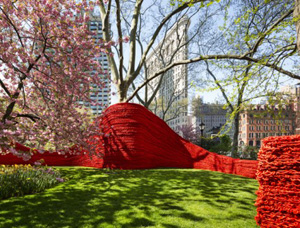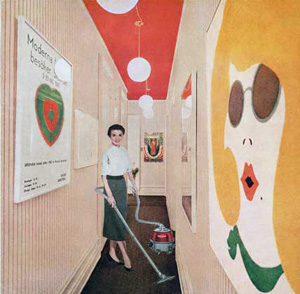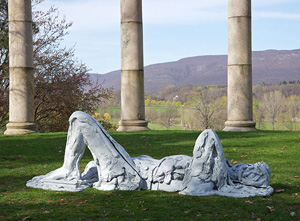The Fabric of the City
John Haberin New York City
Summer Sculpture 2013: Thomas Houseago
Summer sculpture is no longer just about the parks. How could it be, now that both depend so heavily on private funding, and few parks get nearly enough? The good news, though, is that sculpture flourishes—enough that art is part of the fabric of the city.
Art is very much a part of Manhattan, from the Met's roof to Madison Square. Art belongs, too, to the outer boroughs, including conceptual art in Socrates Sculpture Park. And sculpture still heads update with Thomas Houseago at Storm King. It must be hard for someone like him, playing the primitive in LA. It must be harder still in the quiet majesty of the Hudson Valley in morning sunlight. Houseago does it, though—by calling out to his neighbors. 
Very serious artists
Of course, art is back along the High Line. Caterpillar, for one, a stately white corkscrew by Carol Bove at the promised northern extension, peels apart as it crawls along the way. Mark di Suvero has departed Governors Island, leaving a "park in progress" and a small indoor display of Brooklyn's Sculptors Guild, but Socrates Sculpture Park is more ambitious than ever. The Brooklyn Waterfront Artists Coalition (actually based in Red Hook) promises a return to parks by the water, although with much the same sculptors—but for now one can enjoy how Oscar's Tuazon's three trees (hiding a handball court, a basketball court, and a fountain) blend in so well that msot people will never find them. Still, art takes to the streets as well. One need not settle for that red cube downtown by Alexander Calder.
There is enough, in fact, that one can almost miss it. Jaehyo Lee's "champagne flute" of Korean pine blends in way too easily with Union Square, and for my money the bird on a thirteen-foot pole in Soho, by Tracey Emin, really ought to have flown away. I shall take Alexandre Arrechea's word for it that his sculptures along Park Avenue "embody" ten of the city's most prominent buildings. I prefer to think of his bright orange as Pop Art pipe fittings—and their successors, steel shards by Albert Paley, as the artist's embarrassing secrets put through the paper shredder. Claes Oldenburg could easily take credit. Elsewhere, however, things get very, very serious.
The Very Serious Artists start in City Hall Park, where they have the nerve to call their weight "Lightness of Being" (without, alas, the "unbearable")—for ballooning plinths by Franz West, stacked totems by Gary Webb, concrete cucumbers by Sarah Lucas, an entire tractor by James Angus distorted by perspective like the skull for Hans Holbein in Ambassadors, and worse. Across from the Plaza Hotel, at the entrance to Central Park, Thomas Schütte binds two bronze figures together twice over, each pair wrapping the three posts that holds it up. United Enemies, he insists, is kinda, sorta about corrupt Italian politicians but really just mythic. In German Neo-Expressionism, it appears, art can still be about anyone and no one. Thomas Houseago has something of the same yearning for profundity, but the sheer beauty of Storm King unleashes his comic instincts, too, just as for Dennis Oppenheim. It also puts his creative side in touch with any number of sculptural traditions.
Seriousness is not all bad, as with Imran Qureshi and his Mughal-era miniatures transformed into a seemingly blood-spattered Met roof garden. I desperately wanted it back after the oversized fairy tales by the Hudson from Paul McCarthy, extending his stay indoors in Chelsea. Besides, when it comes to seriousness, Ugo Rondinone earns his the hard way. The nine colossal stone figures in Human Nature adapt Stonehenge and Easter Island to Rockefeller Center, but the strict post and lintel design (well, make that two lintels apiece plus a head) gives them an almost Minimalist architecture. So does the strict north-south and east-west alignment, but with an arbitrary placement that creates its own geometry. His small, irregular studies in the gallery look fussy by comparison.
The largest summer sculpture of all is the most open to the sky. It is walls, at once standing guard over the grass and protecting those within. Orly Genger passes on the central lawn of Madison Square. Instead, she surrounds each of three side lawns with Red, Yellow and Blue. That means exactly what it sounds like—each saturated in a single color. One spots only the closest on first approach, and it could easily be a work to itself.
Genger's contribution to Exit Art's final venue began with knitting, and here each wall has the texture of weaving. It is, though, a coarse weaving, as if blown up to scale of art. She assembles it from rope, the kind used for lobster fishing, resisting the elements more even than public sculpture requires. And each third rises and falls like a wave. One can move from one to the next to take in both its firmness and its own unique rhythms. Public art this summer has made a good catch.
The very idea of a park
You do not, I suspect, head for the park for conceptual art. In a more intellectual mood, you might visit a gallery—or buy a book—but summer sculpture in the park as conceptual art? Certainly not Socrates Sculpture Park, founded by Mark di Suvero and others on the Queens waterfront. It still feels neighborhood friendly, right down to the sculpture on hand by John Ahearn and, this summer, a "Broadway billboard" over the entrance. Chitra Ganesh pictures a cartoon deep-sea diver, female, exploring a nuclear wasteland "of immortal jellyfish, of unspoken pleas & mechanical hands." This once, though, conceptual art is as casual as a summer barbecue and, now and again, as happening.
"do it (outside)" even sounds like a happening. It also blends in with two installations more sensitive to the park itself. Heather Rowe constructs Beyond the Hedges (Silvered Gazebo), not unlike her gazebo in the 2008 Whitney Biennial, from grass, mirrors, and the white lattice of a backyard fence. tree word, by Toshiro Oki, opens itself to the air and the rain while hinting at shelter. The architect raises his bare wood frame off the ground, as if in response to Hurricane Sandy. He also builds it around a tree, beneath a comically ornate chandelier.
The larger show, too, looks under construction, because that is how it thinks of conceptual art. It consists of crossed passageways, in a design by Taryn Christoff and Martin Finio, like sidewalk sheds at a construction site. Outside, closest to Broadway, Franz West leans broomsticks swaddled in bandages and plaster. Within, Alison Knowles leaves out bright red folding chairs and lawn umbrellas, although probably not for seating. Oh, and there is text, inside and out, because this is conceptual art. The curator, Hans Ulrich Obrist in collaboration with Independent Curators International, speaks of "scores" for "human interpretation" by sixty artists, although I truly lost count.
 Anyone would lose count, because anyone would grow tired of reading. Still, the project grew organically, like the very idea of a park. Obrist conceived of it twenty years ago, and he has been adding artists ever since, insisting only that a concept finds its execution—unless, of course, the concept leaves its execution to the. Some of the art, too, has been around for a while, like Mel Bochner in his 1968 demand for "unmarked, unoccupied space" and Robert Morris's 1969 stone circle, with the proviso to add something each day. Other works include a wall drawing by Sol LeWitt, a Ricky Board (whatever that means) by David Lynch, Ernesto Neto picking out three birds in flight, and yet another pile of candy by Félix Gonzáles-Torres. Where this park usually runs to emerging artists, here the cast has decidedly emerged.
Anyone would lose count, because anyone would grow tired of reading. Still, the project grew organically, like the very idea of a park. Obrist conceived of it twenty years ago, and he has been adding artists ever since, insisting only that a concept finds its execution—unless, of course, the concept leaves its execution to the. Some of the art, too, has been around for a while, like Mel Bochner in his 1968 demand for "unmarked, unoccupied space" and Robert Morris's 1969 stone circle, with the proviso to add something each day. Other works include a wall drawing by Sol LeWitt, a Ricky Board (whatever that means) by David Lynch, Ernesto Neto picking out three birds in flight, and yet another pile of candy by Félix Gonzáles-Torres. Where this park usually runs to emerging artists, here the cast has decidedly emerged.
The Brooklyn Museum has already traced the birth of conceptual art, in tribute to Lucy R. Lippard, the writer and curator. And Lippard herself contributes—a request to "do something that is: visually striking, socially radical, conceptually and contextually sensitive, sustainable, in the public domain (outside of art venues), and hurts no living thing" while changing the world. (As she concludes, "Good luck!") More interesting is how the shows differ. Where Brooklyn helped one see conceptual art's realization as art object, "do it" leans to exuberance and optimism, the kind that ends up scattered to the wind. This is, after all, the great outdoors, where you can always bring a good book about conceptual art.
Sure, Paul McCarthy has his adolescent cruelty and Bruce Nauman a steel wall to put maximum pressure on one's palms, so that one knows one is alive. Nancy Spero explains how to "expel male presences" (with a fertility goddess and a clothesline), Minerva Cuevas requires that "dysfunctional zones" be "identified and addressed," and Suzanne Lacy will not rest until each and every one of you has made a statement about abused women. Several artists have a food fixation, including Rivane Neuenschwander (in a duel of two chefs), Douglas Gordon (with tequila and champagne), Pedro Reyes (who considers food a "compatibility test for couples"), and even Martha Rosler, who has never had much patience with "body beautiful" or a woman stuck in the home. Still, there are memories of a childhood summer in a tree of wishes by Yoko Ono as conceptual art, help in killing a bug from John Baldessari, Joan Jonas's dance with a piece of chalk, Christian Marclay listening attentively, Darren Bader's wish to glue a table to the sky, or Tacita Dean with a four-leaf clover on a sunny day. As Michael Smith points out, you can always make a group show by picking three artists and adding your name, and Xavier Le Roy promises to meet you there. Or as Jérôme Bel says, "Shut up and dance."
Native to the hills
Thomas Houseago's sculpture is still dark, even when he gives his bronze a patina of white. His striding figures still move as in a prehistoric ritual, even though the earliest dates to 2007—and much else to just the last two years. Their mass is somewhere between pompous and imposing, even when he calls the tallest, at more than fifteen feet, a ghost. Their surfaces look jagged and torn, even when they seem to melt. Their masks refuse the light, maybe especially when one eye becomes a round, open hole. "As I Went Out One Morning," after a line by Bob Dylan, might have one rising at dawn, if only for the bus to Storm King.
This is serious business. Now based in Southern California, Houseago would look just fine alongside Magdelena Abakanovich or Paweł Althamer, and he appeared in the 2010 Whitney Biennial along with such other immigrants as Huma Bhabha, with much the same cuts and hulks, and Piotr Uklanski, whose "textile paintings" parallel Hoseago's turning to two dimensions in charcoal and felt. He also appeared with Bhabha in City Hall Park that summer, on the theme of "Statuesque." Europe has long had a weakness for solemnity in sculpture, back to when early Modernism reached out to African art to defy good taste. And one can see why it lasts, after the Holocaust and more. It is not just about appropriating "the other," although critics have compared "the primitive" to colonialism. It is essential history. 
Still, Houseago really does respond to Storm King, and it frees him up to play. It also makes plain his sophistication. The twenty-seven works offer a fine midcareer retrospective, starting with a drooping white plaster skull on the main building's front wall. From there, he calls out not just to the distant mountains, but to the incredible variety of sculpture around him. Maybe he will never be statuesque, in the sense of grace and beauty, but neither is Louise Nevelson or Ursula von Rydingsvard beside him. The former brings out his planar surfaces and connection to Surrealism, as in the seeming corpse of his Sleeping Boy. The latter's spreading column stands near his Light House and Large Lamp—the latter actually lit from within.
Keep looking, and the lessons in art history keep coming. The arm trailing one striding figure may derive from the wing of the Victory of Samothrace, the arm cocked over another's head a Michelangelo Slave. Houseago calls out even more directly out back, with two thick hemp and plaster chairs. One faces Storm King's collection of David Smith, the other its nearby cluster by Alexander Calder. They may not make comfortable seating, but then Houseago is not into creature comforts. I have a harder time with a bow to pop culture, a mask after Darth Vader, but then if anyone or anything takes seriously an appeal to the raw, crude, and mythic, it is a Hollywood action picture.
The sophistication extends to his consciousness of his materials, not least when he transforms them in bronze. Houseago calls those chairs Studio Seats, as a reminder of the artist at work. He leaves the lumps from clay, along with his fingerprints, while rebar serves as outlines for broad or webbed feet. Yet he also wants the play with materials to be just plain play. He figures that a standing owl will appeal to kids. And he could be right, despite its ominous empty eye.
No question, though, but this is a somber occasion. The echoes of the past insist on its importance, just like the largely male cast. The artist grew up in Leeds, with Henry Moore available as an influence, and a face looks back to Alberto Giacometti and Spoon Woman. Lumpy aluminum disks, as Coins, recall an emerging artist's poverty, but this is literally big money. Part of me will never accept phallic pillars and apelike crouches as a measure of feeling. Still, maybe the snakes truly are native to the grass.

Alexandre Arrechea ran on Park Avenue only through June 9, replaced by Albert Pale through November 8, but on Broadway north of Union Square through the summer, Ugo Rondinone in Rockefeller Center Plaza through June 7, and Thomas Schütte in Doris C. Freedman Plaza through August 25. Chitra Ganesh, Heather Rowe, and Toshiro Oki ran in Socrates Sculpture Park through August 4, "do it (outside)" through July 7. Most summer sculpture, however, ran at least through Labor Day, including art on the High Line through next May, "Lightness of Being" through December 13, the Brooklyn Waterfront Artists Coalition in East River State Park and Brooklyn Bridge Park through September 15, Orly Genger in Madison Square Park through September 8, and Thomas Houseago at Storm King Art Center through November 30. In the galleries, Paul McCarthy ran at Hauser & Wirth in Chelsea though June 13 and in shows both there and on the Upper East Side through July 26, Rondinone at Barbara Gladstone through July 3. Separate reviews visit David Brooks, also at Storm King, and Imran Qureshi on the roof of The Metropolitan Museum of Art. I look separately at summer group shows in the galleries and their baggy themes, plus summer 2017, summer 2018, summer 2019, summer 2020 and its extension into fall, summer 2021, summer 2022, summer 2023, and summer 2024.




